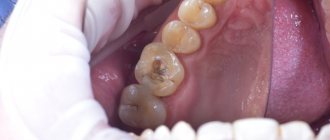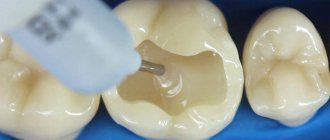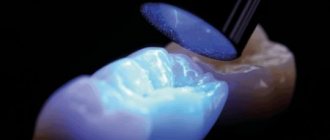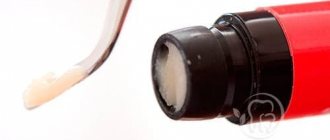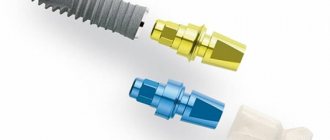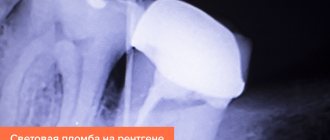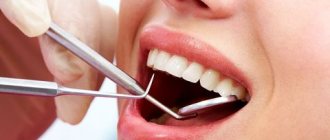Statistics from dental practice confirm the fact that light fillings are most often used and are gradually replacing other filling materials. This happens due to the objective advantages and high performance of fillings in practice.
Specialists from the network of dental clinics "LeaderStom" use light fillings of the latest developments and recommend this material for the restoration of crowns and the elimination of caries. If you notice the first signs of tooth decay and plan to eliminate it in a timely manner, then the LeaderStom clinic will be able to provide you with exactly the quality that meets the most progressive standards of dentistry.
Ceramic filling CEREC with a 50% discount
Heliocomposite composition
To understand how a light filling differs from a regular one, you need to know its composition and principle of operation. Light-curing fillings consist of a polymer matrix, glass-ceramic filler and bonding material. The principle of polymerization is a substance that breaks down into free radicals under the influence of ultraviolet rays. These radicals are responsible for the hardening of the material. The quality of stability and strength of the material depends on the size of the particles in the filler.
They can be: • mini-filled; • macro-, micro-filled; • nanohybrid.
The choice of material composition is determined by the dentist, based on hardness parameters or decorative priority.
The light filling performs the function of protecting tooth tissue from mechanical and chemical irritants. It prevents pathogenic microbes from entering the tooth and withstands significant daily loads. Therefore, the requirements for the quality of filling material are very high, and the light filling fully lives up to the expectations placed on it.
Tooth filling using light heliocomposites
06/04/2019 The filling can be either simple cement or made from high-tech materials called heliocomposites. The following names for these materials are common in everyday life: “helium filling”, “light filling”, “light-curing filling”, “reflective filling”, etc. The essence of this material is in the title:
- Helio - from the Greek word helios, i.e. sun, light
- A composite is a material that contains many particles that perform their specific function.
Heliocomposite is a modern material that we use every day, having long ago abandoned cement fillings, which have neither aesthetics nor strength and can only be used as a temporary filling.
Restoring a carious tooth with heliocomposite is the main method of caries treatment. Under anesthesia, the dentist carefully removes all carious tissue down to healthy dentin and carries out antiseptic treatment of the cavity. Further, if necessary, if the cavity is deep and borders the nerve, the doctor will apply a pad made of a special material to protect the nerve itself. Then the material itself is applied layer by layer into the cavity, with each layer illuminated by a special lamp, which makes it harden. Thus, we get a tooth cured of caries and restored with heliocomposite, which will serve for a long time and not bother you, because heliocomposite itself has many advantages, such as:
- Strength. Withstands chewing loads and does not crumble unlike cement
- Aesthetics. Available in a variety of customizable colors
- Tightness. The formation of secondary caries under the filling is minimized, since microorganisms cannot penetrate under it. Heliocomposite is similar in its physical properties to tooth tissue, has comparable strength, elasticity, and color.
In terms of stages and materials, restoration of a carious tooth with heliocomposite is similar to restoration with composite material. But only during restoration does the doctor use other methods of applying the material and shaping its anatomical and color features, which is labor-intensive. We also use a material that has an expanded range of colors and nanoparticles in its composition, which give a natural shine to the restoration itself.
I would especially like to note that all stages of restoring a carious tooth with heliocomposite in our World of Smiles dentistry are included in the cost of caries treatment. You receive anesthesia and possible therapeutic pads absolutely free.
Durability
The average lifespan of light seals is about five years. However, in practice, they can keep the tooth intact for much longer. For greater durability of the filling, dentists at the LeaderStom clinic recommend carefully monitoring oral hygiene, proper nutrition and sufficient calcium intake into the body.
Stable fastening of the light filling is achieved through an adhesive system - a special light-sensitive liquid that is used to treat the tooth walls. Performing the function of “glue”, it so firmly connects the photopolymer material with the tooth enamel that subsequently a chemical calcium exchange begins to occur between these tissues.
Types and compositions of popular fillings for baby teeth
The most popular in pediatric dentistry:
- Chemically cured fillings made of glass ionomer cement. The material contains fluoride ions, which are responsible for the remineralization of tooth enamel and prevent the proliferation of pathogenic bacteria. Positive characteristics include non-toxicity, biocompatibility, low shrinkage, and good fixation on different surfaces. The filling composition performs well when working with chewing teeth. It is often used under a crown for children's prosthetics. There is only one serious drawback: it takes about a day for the filling to dry completely.
- Metal fillings based on silver amalgam. When hardened, the compounds look rather unaesthetic, so they are used when filling distant teeth. Fillings are famous for their durability. Due to their pronounced antibacterial properties, secondary caries does not form underneath them.
- “Light” photopolymer fillings. The light-curing composite is plastic and easy to use - it allows you to recreate the surface of the tooth down to the smallest detail. This is the best material for restoring incisors, but is also suitable for treating other teeth. The polymer hardens quickly under the influence of a special lamp, but is very sensitive to moisture. Protection from saliva is provided by a rubber dam, a special rubber insulator placed around the teeth being restored.
- Colored compomer fillings. The material is a symbiosis of a hybrid composite and glass ionomer cement, which guarantees double advantages and improved properties. It is convenient to control the colored filling based on the degree of wear - changes in the shade indicate the need to visit a doctor.
All fillings, with the exception of colored fillings, are used equally successfully in both pediatric and adult dentistry, which inevitably leads to the question: is it possible to give children adult fillings?
Biological compatibility
It is known that filling material such as amalgam, which was used several years ago for dental treatment, contains mercury in its composition. Another material, glass ionomer cement, is also used in dentistry, but contains fluoride, which recent research suggests may be harmful to the pineal gland. In this range of filling materials, light fillings are distinguished by their maximum biological compatibility. They do not emit toxic substances, do not destroy the tooth crown (as cement composites do due to higher hardness than the tooth), and have optimal expansion-compression characteristics under temperature changes.
Caries of baby teeth
The appearance of caries greatly complicates the life of the baby and his parents.
Baby teeth are prone to rapid destruction and literally in 2-3 weeks an inconspicuous white dot on the enamel turns into a full-fledged carious cavity. If the tooth is not treated, then in the future it will lead to the development of pulpitis, periodontitis, and loss of a baby tooth. Filling has been and remains the most effective method of combating caries. The pediatric dentist will examine the child’s oral cavity, assess the extent of the damage, and select the appropriate filling material. And there is one undeniable advantage of paid treatment. State clinics are limited by VHI requirements for the selection of compositions, but in Aza&Buka pediatric dentistry they use really good and durable material.
When choosing a filling material, the pediatric dentist takes into account several factors:
- the age of the patient and his ability to withstand prolonged treatment;
- neglect of the carious process;
- characteristics of the child’s physical and emotional state.
High aesthetic characteristics
The aesthetic factor is especially important when eliminating caries on the front teeth. The material of the photo light seal lends itself perfectly to final processing: grinding and polishing. And the color set provided by raw material manufacturers includes the full range of possible shades of tooth enamel. This fact allows you to accurately imitate the natural color of the tooth in the absence of boundaries between the enamel tissue and the filling. Even after several years of use, it can be quite difficult to determine this boundary, and immediately after tooth restoration it is simply impossible.
The effect of preserving tooth color gradations is possible thanks to the use of the latest layer-by-layer application technologies. The so-called polychrome filling uses more than two color components: darker at the base of the tooth and lighter towards the cusps. The most modern compositions of filling materials used in the LeaderStorm clinic were developed using nanotechnology. They allow you to achieve maximum aesthetic effect when restoring a tooth.
There are rare exceptions when priority is given to chemical composites. For example, when installing the material in a place that is difficult to reach for ultraviolet radiation. If a tooth restoration is carried out with a light filling, then the light polymerization will not be effective and the composite will not harden properly. In such situations, a chemically cured material is recommended.
All of the above advantages of light seals, reviews are very positive, which is confirmed in practice.
Features of the light seal
The material for the manufacture of a light-curing filling is a composite, which polymerizes under the influence of ultraviolet radiation. The layer-by-layer technology, in which the photocomposite layer does not exceed 2 mm, gives the installed filling high strength and durability. And the plasticity of the material allows you to restore the natural shape of the tooth.
These positive properties of the filling are directly related to its rather complex composition:
- The polymer matrix is the basis of the filling. When exposed to light, the material breaks down into radicals that promote hardening.
- Filler. Silicon dioxide, glass ceramics and other types of filler form the structure and color of the filling.
- Additional substance.
A significant advantage of a light-composite filling is the complete absence of substances harmful to the human body; it is absolutely non-toxic.
Light-curing composite fillings, depending on the composition of the filler, are of the following types:
- Microfilled (ideal for recreating the tooth structure in the smile area). Small filler particles retain their color well, are easy to polish, but are quite fragile and cannot withstand heavy chewing loads, so they are recommended for installation on the front teeth.
- Macro-filled (most often used for chewing teeth). Thanks to macrophiles, which are large solid particles, the filling is quite solid. However, given the roughness of the surface and the ability to lose its color over time, it is installed on the chewing teeth or on the inside, where the filling is not so noticeable.
- Mini-filled (proven well for filling cavities of classes I and II). Fillings are characterized by high strength, they are resistant to abrasion, but there is no opportunity to polish the surface to a perfect shine.
- Nanohybrid (universal). Ultrafine particles of mini- and micro-filled composites, which are part of the filling material, are durable and look aesthetically attractive. Such fillings are suitable for all types of restoration.
Light fillings are a universal solution in modern dentistry, because the dentist has ample opportunities to choose for each patient his own shade of material, which does not change color when using products that stain teeth enamel. This valuable property of a photopolymer filling is especially important in the treatment and restoration of anterior teeth, as it allows you to completely restore the functionality and aesthetics of a damaged tooth and return the beauty of a smile to the patient.
So, the advantages of light polymerization fillings include:
- soft consistency of the filling composition. This allows you to qualitatively fill the entire cavity and ensures a tight fit to the edges of the tooth;
- high plasticity of the material. The specialist has the opportunity to shape the crown part of the tooth without fear of premature hardening. The seal gains its strength only under the influence of an ultraviolet lamp;
- hypoallergenic and non-toxic composition. The filling is harmless to the patient’s body and has no restrictions for installation by pregnant and nursing mothers;
- wide palette of shades. During restoration, a color identical to the patient’s enamel is selected;
- Composite compliance. The material is convenient to polish and easy to grind.
Fillings made of chemically cured composite
They harden due to chemical reactions that occur during the interaction of the components of the filling. The filling contains an organic matrix and an inorganic filler. The paste and special catalysts are mixed before applying the paste and after a few minutes they harden into the desired shape. If necessary, the dentist polishes them, making them more comfortable and natural in shape for the patient. Complete curing occurs within a day. The composite material is durable and aesthetic, suitable for restoring anterior teeth.
Advantages of chemical composite fillings:
- Large color palette;
- High strength;
- Uniform curing regardless of filling size;
- Does not dissolve from saliva;
- Do not split or crack.
Disadvantages of chemical composite fillings:
- May shrink over time
How much does a light-curing filling cost?
The question “how much does it cost to install a light seal” is not so easy to give a definite answer. This will largely depend on how advanced the disease is. If the tooth is quite seriously damaged or it has to be heavily drilled, then the doctor will have to work hard. The amount of work to be done and the amount of material used directly affect the cost of the light seal. Therefore, the sooner you contact a specialist to solve your problem, the less you will end up spending.
At Doka-Dent clinics, a light-polymer filling costs from 3,800 rubles - this is approximately the average price in the capital. The doctor will be able to make a more accurate calculation only after examination and diagnosis. Please note that x-rays, anesthesia and various medical procedures are paid separately.
Sealing
After the above-described list of preparatory measures, the doctor proceeds to actually filling the open hole in the tooth. This is where the creative stage of a dentist’s work begins, because teeth are individual – in color and shape. In an effort to maintain the attractiveness of a smile and ensure the strength of the affected tooth when chewing food, the doctor sculpturally lays the filling substrate in layers. Each layer is illuminated with ultraviolet light, a new layer is applied to the hardened area, and so on until the work is completed.
How to care for your mouth after having a light filling installed
How long after light filling can you eat? In order to maintain the original characteristics of the light seal, it is recommended:
- After installing the light filling, it is recommended not to eat for 2 hours.
- For three days after filling, avoid consuming staining foods and drinks;
- Strictly follow hygiene procedures;
- Undergo a follow-up examination with a dentist 5-6 months after the filling is installed.
Thus, we have looked at what a light seal is. It makes it possible to restore chewing and anterior teeth with minimal risk of relapse. For example, to restore the aesthetic properties of a smile, it is better to use expensive light-composite materials, and for restoration of the lateral area, dental materials of average cost are ideal.
Pros and cons of light-based dental fillings
This type of filling has both advantages and disadvantages. Overall, this is an improved treatment option, better than outdated composite materials. As for the positive aspects, the main ones are:
- high plasticity of the material, which allows you to give the filling the necessary anatomy;
- absolute harmlessness – absence of toxic components in the composition;
- the ability to select the optimal shade that matches the color of the teeth;
- stability of the result over time;
- absence of any discomfort after placing the filling;
- the possibility of building up the coronal part, even if more than half is destroyed;
- virtually instant hardening under an ultraviolet lamp.
